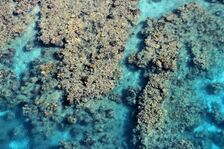Biology:Saddle wrasse
| Saddle wrasse | |
|---|---|

| |
| Scientific classification | |
| Domain: | Eukaryota |
| Kingdom: | Animalia |
| Phylum: | Chordata |
| Class: | Actinopterygii |
| Order: | Labriformes |
| Family: | Labridae |
| Genus: | Thalassoma |
| Species: | T. duperrey
|
| Binomial name | |
| Thalassoma duperrey (Quoy & Gaimard, 1824)
| |
| Synonyms | |
| |
The saddle wrasse (Thalassoma duperrey), also known as Hīnālea Lauwili in Hawaiʻi, is a species of wrasse native to the waters around the Hawaiian Islands[2] and Johnston Island.[3] They are found on reefs at depths from 5 to 25 m (16 to 82 ft). This species can reach 28 cm (11 in) in total length. This species can also be found in the aquarium trade.[4]
Description
Adults of the saddle wrasse have a dark blue-green head followed by a dull orange band that will intensify during the spawning seasons, as for the rest of the body it is blue-green with numerous magenta arrows running down the sides.[2] Terminal males typically have a white bar around the orange band that is able to be turned on or off, as well as a crescent-shaped tail fin.[2] Juveniles tend to be more whitish with a dark stripe that runs from the top of the head to the tail. Smaller adults are able to revert to the juvenile coloration to avoid harassment from larger fish.[2] Saddle wrasses can grow up to 11.5 inches (29.21 cm) in length.[5][3]
Distribution
Saddle wrasses are endemic to Hawaii as well as Johnston Atoll, where they are very common.[3][6]
Habitat
Saddle wrasses can be found in intertidal and shallow habitats down to about 70 ft (21.34 m) of depth.[2] They are found in areas with a lot of corals, rocks, nooks, and crannies to have a quiet get-away and hiding place from potential threats.[5] These fish sleep hidden in holes or burrows in sandy areas.[5]
Diet
Saddle wrasses are carnivores and opportunistic feeders, consuming anything that will become available to them.[5] As juveniles, they will tend to be considered “cleaners'': such as picking parasites from larger fish or animals, but as they mature they will start to scavenge for worms, shells, mollusks, shrimps, and other crustaceans.[5][2] They have canine teeth and pharyngeal bones near their gills in order to help crush the shells.[5]
Human use & Cultural Significance
Hīnālea were integral to society and fishing communities in Hawaii as a staple food and regular item in the Hawaiian diet.[6][7] They were also regularly used in ceremonies and offerings to Hawaiian gods and goddesses.[6][7] Specific fishing practices include melomelo, where club-like sticks were charred and anointed in oil to attract hīnālea when submerged underwater.[7] Fishermen, or lawai‘a, wove baskets, called hīnaʻi hoʻoluʻuluʻu, out of vines of the endemic ‘āwikiwiki plant, which then were weighted and dropped into the ocean to trap hīnālea.[7]
References
- ↑ Shea, S.; Liu, M.; Sadovy, Y. (2010). "Thalassoma duperrey". IUCN Red List of Threatened Species 2010: e.T187711A8608670. doi:10.2305/IUCN.UK.2010-4.RLTS.T187711A8608670.en. https://www.iucnredlist.org/species/187711/8608670. Retrieved 19 November 2021.
- ↑ 2.0 2.1 2.2 2.3 2.4 2.5 Hoover, John P. (2008). The ultimate guide to Hawaiian reef fishes sea turtles, dolphins, whales, and seals. John P. Hoover. Honolulu: Mutual Pub. ISBN 978-1-56647-887-8. OCLC 243960518. https://www.worldcat.org/oclc/243960518.
- ↑ 3.0 3.1 3.2 "Thalassoma duperrey, Saddle wrasse : aquarium". https://www.fishbase.se/summary/Thalassoma-duperrey.
- ↑ Froese, Rainer and Pauly, Daniel, eds. (2013). "Thalassoma duperrey" in FishBase. October 2013 version.
- ↑ 5.0 5.1 5.2 5.3 5.4 5.5 "There's Nothing Common About The Common Saddle Wrasse" (in en-US). 2016-05-10. http://www.keliiskayak.com/theres-nothing-common-commonly-seen-saddle-wrasse/.
- ↑ 6.0 6.1 6.2 Titcomb, Margaret; Pukui, Mary Kawena (1977) (in en). Native use of fish in Hawaii (2nd ed.). Honolulu: University of Hawaii Press. ISBN 0-8248-0592-5. OCLC 10482126. https://www.worldcat.org/oclc/10482126.
- ↑ 7.0 7.1 7.2 7.3 "Reef Fish Are Living Connections to Hawai‘i’s Culture & Past" (in en-US). 2020-03-09. https://mauioceancenter.com/reef-fish-are-living-connections-to-hawaiis-culture-past/.
Wikidata ☰ Q1871141 entry
 |



